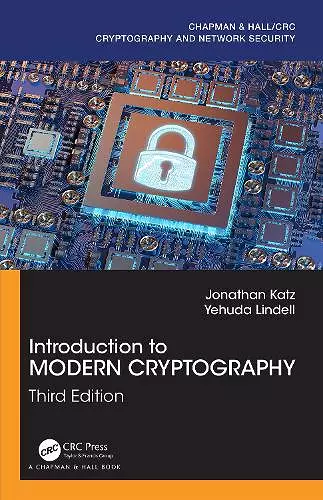Introduction to Modern Cryptography
Foundational principles and practices of cryptography
Jonathan Katz author Yehuda Lindell author
Format:Hardback
Publisher:Taylor & Francis Inc
Published:21st Dec '20
Currently unavailable, our supplier has not provided us a restock date

This textbook serves as a foundational resource for understanding modern cryptography, emphasizing formal definitions and security proofs. Introduction to Modern Cryptography is essential for students in the field.
The Introduction to Modern Cryptography is widely recognized as the leading textbook for introductory courses in cryptography, both in mathematics and computer science. This Third Edition enhances its predecessors by incorporating new sections, topics, and exercises that reflect the latest advancements in the field. The authors skillfully present the foundational principles of modern cryptography, ensuring that readers grasp the significance of formal definitions and the importance of rigorous proofs of security.
In this edition, readers will find an expanded exploration of essential concepts, making it an invaluable resource for students and educators alike. The authors have meticulously crafted the content to not only cover theoretical aspects but also practical applications, bridging the gap between abstract ideas and real-world scenarios. The emphasis on clarity and accessibility makes the Introduction to Modern Cryptography suitable for a diverse audience, from beginners to those seeking a deeper understanding of cryptographic techniques.
With a focus on fostering critical thinking and problem-solving skills, this textbook includes a wealth of exercises designed to reinforce learning. Whether used in a classroom setting or for self-study, the Introduction to Modern Cryptography serves as a comprehensive guide to the principles and practices that underpin the field of cryptography today.
The organization is quite natural, and aligns well with my course. My course covers the topics in exactly the same order as in Katz and Lindell, except that we skip some sections due to time constraints. I actually find Chapter 1 (Introduction) among the strongest aspects of this book. It does an excellent job discussing historical cryptography, explaining the motivation behind "modern cryptography," and introducing the non-expert to some of the basic concepts on which the rest of the contents of the book are built. I think this is an excellent textbook, and I can find very little fault with it. As I mentioned above, a possible suggestion is to add some more modern topics (lattice crypto, code-based crypto, FHE, obfuscation etc.) On the other hand, as an introductory textbook, it is perhaps also fine without those more advanced and more modern topics. - Gorjan Alagic
I find Chapters 2 and 5 to be the best. Both for its clarity. Chapter 2 is clear on certain details that, in my view, make the material much easier to understand than other treatments I have come across. E.g., clearly clarifying that when we consider the notion of "secret," we address the case only that one single message is sent. Not multiple messages. This really helps one quickly understand the technical details and proofs. Similarly, Chapter 5 on hash functions, in my view, is tricky to present. E.g., it must be clear that one is not dealing with a particular instance of a collision, but really finding collisions. This distinction is made very clearly in this book.- Mahesh Tripunitara
ISBN: 9780815354369
Dimensions: unknown
Weight: 1100g
648 pages
3rd edition